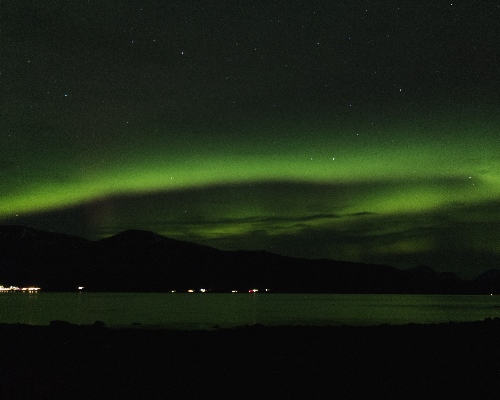My daughter Elizabeth recently photographed the northern lights (aurora borealis) in Tromsø, Norway, about 3° above the Arctic Circle.

I haven’t seen the northern lights in person, and I didn’t know until she told me that the lights appear gray to the naked eye, like smoke. Sometimes the lights have a hint of color, but the color is nowhere near as intense as in photographs. Photos like the one above are not false color images. The green light is really there, even though it is not nearly as vivid to the naked eye as it is to a camera.
The reason the aurora appear gray is that human eyes don’t see in color well in dim light. At very low light levels, our vision is based entirely on rods, photoreceptor cells that are very sensitive to light but not to color. If aurora are bright enough, cones are activated and color becomes visible.
Why green in particular? It comes from excited oxygen atoms, emitting radiation at a wavelength of 557.7 nm. Other colors can be found in aurora, but green is most common for physical and physiological reasons. The physical reasons involve radiation and the chemical composition of the atmosphere. The physiological reason is that human vision is most sensitive around the frequency of green light.

I live in Iceland, and while it is indeed true that relatively weak Northern Lights have more of a grey shade in our perception, it is not uncommon to see stronger displays that are a quite vibrant green to the naked eye. Red and purple hues are more rare but also possible.
One other detail is that most photographs use a relatively long exposure, which increases brightness but blurs the fine tendrils that Northern Lights might display when perceived directly.